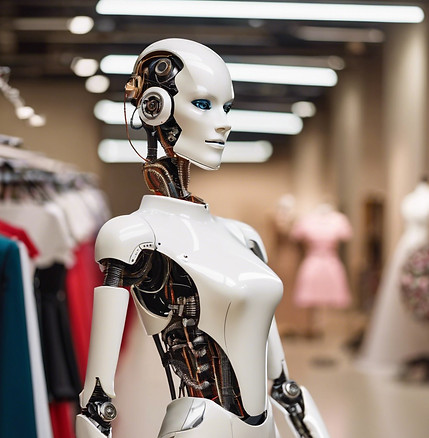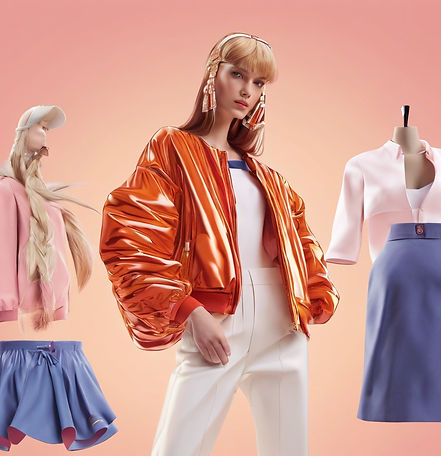Artificial Intelligence (AI)
AI in Fashion

Artificial intelligence (AI) will likely be a major disruptor in fashion in the near future. Some predict that spending on AI in fashion will rise from USD 229 million to USD 1260 million by 2024 at a compound annual growth rate of 40.8% (Zou & Wong, 2021). According to the report of Market Scoop, AI in the fashion market is expected to reach USD 23,936.3 Million by 2033 (Pangarkar, 2024). In a review of studies on AI over the past decade, Zou and Wong (2021) divided the research into seven categories, of which studies on design accounted for 21.3% of the total.
The use of artificial intelligence (AI) in fashion design and the use of digital automation tools in fashion design processes (algorithmic fashion design) are transforming the way that fashion designers work. Levi Strauss & Co. utilized AI algorithms to create new and fresh design options for denim jackets and enhance their production and manufacturing workflows (Lee & Kim, 2024). Algorithmic models assist fashion designers through machine learning in which the input of large datasets generates new output. Särmäkari and Vänskä (2022) use two case studies to demonstrate how a fashion designer’s expertise is combined with computer-generated content to alter the design process. The first case is about generative clothing design by Finnish designer Matti Liimatainen, a former mechanical engineer who combines design and patternmaking with mathematics and computer science. He teaches the machine to design clothes where the designer sets the parameters. He runs 3 projects: Self-Assembly, ITSE (as the ‘Lego’ of fashion), and Syntax of Clothing. The first two projects create ready-to-assemble garment kits. These garments can be assembled, without sewing, based on a special loop-and-hole seam. See Figure 1. Panels and assembled coat with Liimatainen’s special seam (Särmäkari & Vänskä, 2022, p. 3). The designer’s third project is about developing algorithmic language and grammar for different stages of fashion design and production. He aims for a ‘posthuman’ process that requires no human involvement. This automation process has been divided into 6 stages: brief, design, interpreter, description, fabrication, and use. Liimatainen questions the role of the designer and believes that the aim of AI should be to advance fashion design instead of just replacing the human designer. The other case study by Särmäkari and Vänskä (2022) is on the Dutch ‘digital-only’ fashion house The Fabricant, about the use of AI in digital fashion sketching. In this case, the designs are digital couture meant for machine-generated images, i.e., for the virtual world and avatars. Digital fashion is an alternative fashion culture and the founders of The Fabricant believe that one should nurture their imaginative and creative side by wearing and customizing digital clothes. The company is famous for its Iridescence dress which auctioned for cryptocurrency worth $9500. It collaborates with blockchain technology companies which authenticate digital assets and turn digital clothes into rare collectibles. Digital 3D representation and 3D software (CLO3D) fuel the design process which, combines fashion with animation, filmmaking and storytelling. Their designers are remotely employed, they have a network of global clients and their audience are ‘digi-sapiens.’ Särmäkari and Vänskä (2022) believe that both Liimatainen and The Fabricant are laying the foundation for algorithmic design practices and that these practices will re-professionalize fashion design (instead of de-professionalizing it). The authors propose the concept of the ‘cyborg designer 4.0’, a physical and digital craftsperson who moves between physical and digital worlds.
Another AI-based creativity support tool (CST), FashionQ, was developed in collaboration with fashion design professionals (Jeon et al., 2021). Three phases of fashion design were identified – recognizing a brand, understanding trends and setting design directions. AI models were developed for the corresponding cognitive operations, which include capabilities of fashion attribute detection, style clustering, style forecasting and style merging.

The analytical interfaces of these capabilities or the three interactive visualization tools of FashionQ are - StyleQ, TrendQ, and MergeQ. FashionQ allows insights obtained from analyzing large-scale fashion image data (about 30,000) to be effectively used. StyleQ provides clustered styles based on a selected attribute. This is supposed to increase divergent thinking. Specifically, StyleQ allows the user 1) to upload a design image, 2) to check the image’s attributes and add/exclude them and 3) provides three styles based on similarities with attributes. TrendQ provides a quantitative definition of trends based on the number of style frequencies in the four fashion cities over a 10-year period. It provides trend group selection and style selection with 3 styles per trend group. This aids in convergent thinking. MergeQ proposes a style based on styles selected from StyleQ and TrendQ. This aids creativity by blending 2 or more concepts.

Jeon et al. (2021) demonstrate the effectiveness of FashionQ in facilitating divergent and convergent thinking through interviews and a user study. The authors demonstrate the role and use of AI to leverage big data and computational capabilities to support creativity in fashion design and also uncover salient aspects that need to be considered while designing AI-based CST for fashion design. They list the limitations of the AI model like attribute detection accuracy issue with fabric type and inclusion of time series data on future AI models for better insights in trend forecasting.
According to Zou and Wong (2021), most current work on AI in design focuses on helping designers visually demonstrate their ideas (e.g., attribute editing, 3D garment generation, etc.). These methods can help in saving time for designers through speeding up design detail modification and in generating marketing material like videos and brochures. The future of AI in design can include challenges like whether AI models can create new designs with predetermined constraints like season, brand image, or whether AI models can transform abstract themes into actual fashion products like garments or accessories. In summary, the use of AI in fashion design has been demonstrated in three use cases. In the first case, a designer teaches a machine to design clothes by setting parameters and designing ready-to-assemble kits and developing an algorithmic grammar for the fashion design process. In the second case, a design company uses AI to create digital couture for avatars by combining fashion with animation and storytelling and collaborates with blockchain technology to authenticate assets. In the third case, an AI-based CST is developed to aid the fashion design process through selecting style attributes and understanding trends. AI models in fashion design are going through rapid evolution and will be used more widely as the design process begins to move seamlessly between the physical and digital world.
References
Jeon, Y., Jin, S., Shih, P. C., & Han, K. (2021). FashionQ: An AI-driven creativity support tool for facilitating ideation in fashion design. Proceedings of the 2021 CHI Conference on Human Factors in Computing Systems, 1–18.
Lee, G., & Kim, H. (2024). Human vs. AI: The battle for authenticity in fashion design and consumer response. Journal of Retailing and Consumer Services, 77, 1-11.
Pangarkar, T. (2024, February 29). AI In The Fashion Market. Market Scoop. https://scoop.market.us/ai-in-the-fashion-market-will-reach-usd-23936-3-million-by-2033/
Särmäkari, N., & Vänskä, A. (2022). “Just hit a button!” – fashion 4.0 designers as cyborgs, experimenting and designing with generative algorithms. International Journal of Fashion Design, Technology and Education, 15(2), 211-220.
Zou, X., & Wong, W. (2021). Fashion after fashion: A report of AI in fashion. In arXiv preprint arXiv, 1-32.





